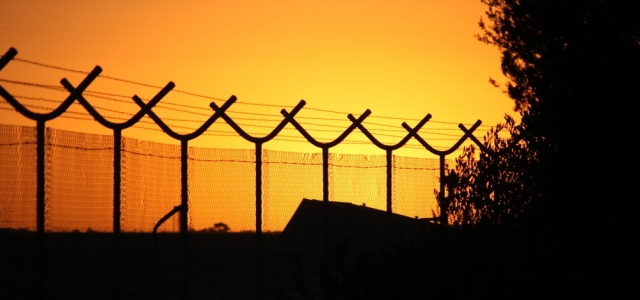 The concept of “border security” is inherently ambiguous. After all, we live in a world where no international border can be completely sealed. The risk that a bad guy will come across the border—by land, sea, or air—can never be reduced to zero, no matter how much money or manpower is funneled into border-security operations. As a result, it is easy for political opportunists to use the notion of “border security” as a smoke screen behind which to advance their own agendas. In the context of the debate over immigration reform, the quest for ever-increasing levels of border security is used as an excuse to oppose any meaningful changes to a dysfunctional immigration system which itself undermines security by its failure to operate fairly or efficiently. This is an irony which is apparently lost on those nativist politicians and activists for whom no level of border enforcement will ever be viewed as sufficient to justify immigration reform.
The concept of “border security” is inherently ambiguous. After all, we live in a world where no international border can be completely sealed. The risk that a bad guy will come across the border—by land, sea, or air—can never be reduced to zero, no matter how much money or manpower is funneled into border-security operations. As a result, it is easy for political opportunists to use the notion of “border security” as a smoke screen behind which to advance their own agendas. In the context of the debate over immigration reform, the quest for ever-increasing levels of border security is used as an excuse to oppose any meaningful changes to a dysfunctional immigration system which itself undermines security by its failure to operate fairly or efficiently. This is an irony which is apparently lost on those nativist politicians and activists for whom no level of border enforcement will ever be viewed as sufficient to justify immigration reform.
The complexity of the border-security equation, and the relative ease with which that complexity is exploited by nativists, were on display at a hearing this week of the House Homeland Security Subcommittee on Border and Maritime Security. The hearing was ostensibly devoted to answering the question “What Does a Secure Border Look Like?” but might very well have been titled “When Is Enough Ever Enough?” Nearly everyone attacked U.S. Customs and Border Protection (CBP) for failing to produce its promised “Border Condition Index,” which—as described by the Congressional Research Service (CRS)—was supposed to “combine multiple dimensions of border security, public safety, and quality of life into a holistic ‘score’ that can be calculated for different regions of the border.” But not everyone at the hearing wanted to draw attention to the fact that CBP has met or exceeded every new “metric” which Congress has placed before it since 2006.
Border Patrol Chief Michael J. Fisher was, naturally, quick to point to the many indictors that border security has improved in recent years: more personnel and technology deployed; fewer apprehensions of unauthorized immigrants; more seizures of contraband; falling crime rates in border communities. Even Rebecca Gambler, Acting Director of Homeland Security and Justice Issues at the Government Accountability Office, who largely lambasted the Border Patrol for its failure to devise “performance goals and measures,” acknowledged that border security has improved as a result of the agency’s actions in recent years.
While these accomplishments were emphasized by some members of the subcommittee, particularly Ranking Member Sheila Jackson Lee (D-TX), other lawmakers were more interested in nativist political theater designed to scare people. Rep. Jeff Duncan (R-SC) lamented that there are ranchers in U.S.-Mexico border communities who don’t feel safe enough to leave their families at home while they go to 7-11 to buy milk for their kids. According to Duncan, these ranchers are menaced by “Other Than Mexicans,” even nefarious Middle Easterners, who cross their land en masse. In similar style, Rep. Lou Barletta (R-PA) said that “any state with an international airport is a border state” due to the ability of foreigners to overstay their visas. In a rambling fashion, he went on to say that immigration reform shouldn’t be used to “make new friends or new voters,” then invoked the memory of the 1993 attack on the World Trade Center and decried the nation’s “open borders.”
There is no denying that measuring something as nebulous as “border security” is a herculean mathematical task. As emphasized by Kevin McAleenan, Acting Assistant Commissioner in the CBP Office of Field Operations, there are “several hundred metrics” for gauging border security, and there is no single number that captures everything. Likewise, Marc R. Rosenblum, Specialist in Immigration Policy at CRS, noted that “no single, quantitative, off-the-shelf indicator accurately and reliably provides a metric or ‘score’ for border enforcement.” Rather, multiple data sources can be used to construct “models of border flows.”
But complexity is no excuse for obfuscation—or inaction when it comes to immigration reform. As Rep. Jackson Lee pointed out, border-security experts say that the transnational criminal cartels which smuggle guns, drugs, and money across the border are the primary threats to security; not “masses of people.” Immigration reform would take those “masses of people” out of the equation and target enforcement resources squarely at the cartels. The opponents of immigration reform fail to see that they are doing a disservice to the nation’s security (not to mention its values) by continuing their relentless and pointless pursuit of men and women who are seeking a better life and pose no threat to anyone.
FILED UNDER: Border, Hearings, Nativists, Republicans, Restrictionists, undocumented immigration


